Peugeot 207 CC 2011 Owner's Manual
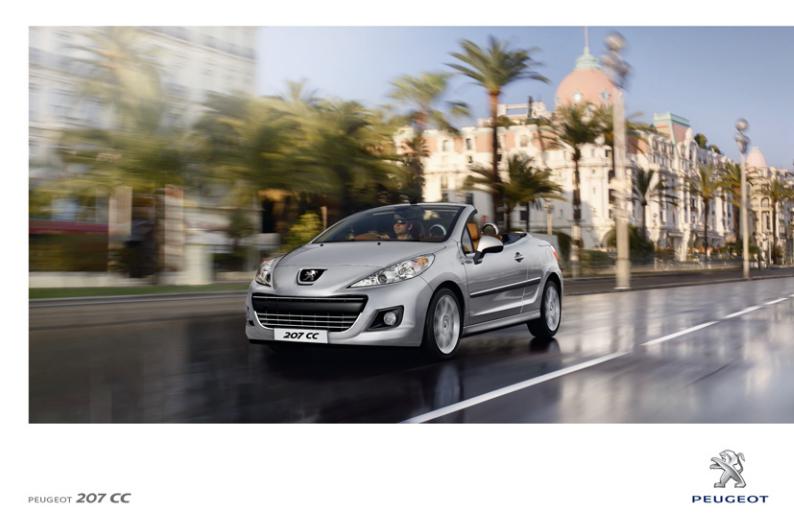
Handbook
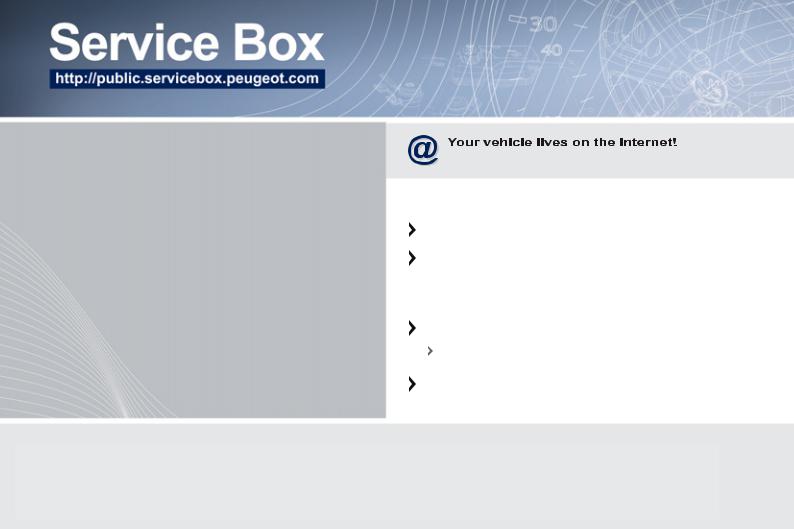
Access the latest information available.
PEUGEOT's SERVICE BOX Internet site permits easy
and free consultation of your vehicle documentation Connect to http://public.servicebox.peugeot.com: on line.
Simple and user friendly, SERVICE BOX allows you access:
●to your Handbook,
●to previous Vehicle documentation.
select your language,
click on the link in the "Private customer access" zone to consult the Vehicle documentation,
A window opens giving access to all of the hand-
books...
select your vehicle,
choose its body type then the date of publication of the handbook,
finally, click on the item which is of interest to you.
!
Please note the following point:
The fitting of electrical equipment or accessories which are not recommended by PEUGEOT may result in a failure of your vehicle's electronic system. Please note this specific warning. It is advisable to contact a PEUGEOT dealer to be shown the recommended equipment and accessories.
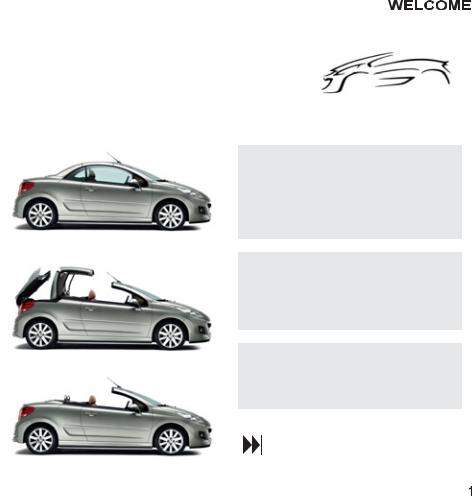
Thank you for choosing a 207CC, a symbol of confidence, passion and inspiration.
This handbook has been designed to enable you to make the most of your 207CC.
On the first few pages, you will find a detailed summary, followed by a quick reference guide intended to make it easier for you to become familiar with your coupé-cabriolet.
All of the details specific to your 207CC, comfort, safety, driving, are then presented in this handbook, to increase your appreciation of the vehicle help you get the most from it.
Each model may only be fitted with some of the equipment mentioned in this handbook, depending on its version and the specification for the country in which it is sold.
Key
!
Warning:
this symbol marks warnings which it is essential to observe for your own safety, for the safety of others or to avoid any risk of damaging your vehicle.
i Information:
this symbol draws your attention to additional information for better use of your vehicle.
 Protection of the environment:
Protection of the environment:
this symbol accompanies advice relating to protection of the environment.
Page reference:
this symbol invites you to refer to the pages which provide details of the function.
CONTENTS
FAMILIARISATION |
4 Î 17 |
|
|
2 COMFORT |
45 Î 64 |
|
|
4 VISIBILITY |
80 Î 85 |
|
|
|
|
■ |
Ventilation |
|
45 |
|
■ |
Lighting control stalk |
80 |
ECO-DRIVING |
18 Î 19 |
|
■ |
Heating |
|
47 |
|
■ |
Static directional lighting |
83 |
|
■ |
Manual air conditioning |
|
47 |
|
■ |
Headlamp adjustment |
83 |
||
|
|
|
■ |
Rear screen demist - defrost |
49 |
|
■ |
Wiper control stalk |
84 |
|
|
|
|
|
|||||||
|
|
|
■ |
Digital air conditioning |
|
50 |
|
■ |
Courtesy lamp |
85 |
|
|
|
■ |
Seats |
|
52 |
|
|
|
|
|
|
|
■ |
Steering wheel adjustment |
54 |
|
|
|
|
|
|
|
|
■ |
Mirrors |
|
55 |
|
|
|
|
|
|
|
■ |
Interior fittings |
|
57 |
|
|
|
|
|
|
|
■ |
Windstop |
|
62 |
|
|
|
|
|
1 |
INSTRUMENTS |
|
|
and CONTROLS 20 Î 44 |
||
■ |
Instrument panels |
20 |
|
■ |
Indicator and warning lamps |
21 |
|
■ |
Indicators |
28 |
|
■ |
Adjustment buttons |
32 |
|
■ |
Screens without |
|
|
|
audio equipment |
33 |
|
■Screens with audio equipment 35
■16/9 colour screen (Peugeot
Connect Navigation) |
40 |
■ Trip computer |
42 |
|
3 ACCESS |
65 Î 79 |
|
|
5 SAFETYCHILD |
86 Î 92 |
|
■ |
Remote control key |
|
65 |
|
■ |
Conventional child seats |
86 |
■ |
Alarm |
|
69 |
|
■ |
ISOFIX child seats |
90 |
■ |
Window controls |
|
71 |
|
|
|
|
■ |
Doors |
|
73 |
|
|
|
|
■ |
Boot |
|
76 |
|
|
|
|
■ |
Fuel tank |
|
77 |
|
|
|
|
■ |
Misfuel prevention (Diesel) |
79 |
|
|
|
|
|
2

6 SAFETY |
93 Î 104 |
■ Direction indicators |
93 |
■Emergency or assistance
|
call |
93 |
■ |
Hazard warning lamps |
94 |
■ |
Horn |
94 |
■ |
Tyre under-inflation detection |
95 |
■Braking assistance
systems |
96 |
■Trajectory control
|
systems |
97 |
■ |
Seat belts |
98 |
■ |
Airbags |
101 |
|
7 DRIVING |
105 Î 115 |
■ |
Parking brake |
105 |
■ |
Manual gearbox |
105 |
■ |
Gear shift indicator |
106 |
■ |
Automatic gearbox |
107 |
■ |
Speed limiter |
110 |
■ |
Cruise control |
112 |
■ |
Parking sensors |
114 |
|
8 CHECKS |
116 Î 122 |
■ |
Bonnet |
117 |
■ |
Running out of fuel (Diesel) 117 |
|
■ |
Petrol engines |
118 |
■ |
Diesel engine |
119 |
■ |
Checking levels |
120 |
■ |
Checks |
121 |
9 INFORMATIONPRACTICAL |
123 Î 147 |
■Temporary puncture
|
repair kit |
123 |
■ |
Changing a wheel |
128 |
■ |
Changing a bulb |
132 |
■ |
Changing a fuse |
136 |
■ |
Battery |
141 |
■ |
Energy economy mode |
143 |
■ Changing a wiper blade |
143 |
|
■ |
Towing the vehicle |
144 |
■ |
Towing a trailer |
145 |
■ |
Accessories |
147 |
|
|
CONTENTS |
||
10 DATATECHNICAL |
148 Î 154 |
|
||
■ |
Petrol engines |
|
148 |
|
■ |
Weights (petrol) |
|
149 |
|
■ |
Diesel engine |
|
150 |
|
■ |
Weights (Diesel) |
|
151 |
|
■ |
Dimensions |
|
152 |
|
■ |
Identification markings |
153 |
|
|
AUDIO EQUIPMENT
and TELEMATICS 155 Î 210
■ |
Emergency or assistance |
155 |
■ |
Peugeot Connect Navigation (RNEG) |
157 |
■Peugeot Connect Sound (RD5) 189
VISUAL |
211 Î 214 |
SEARCH |
|
ALPHABETICAL |
215 Î 218 |
INDEX |
3
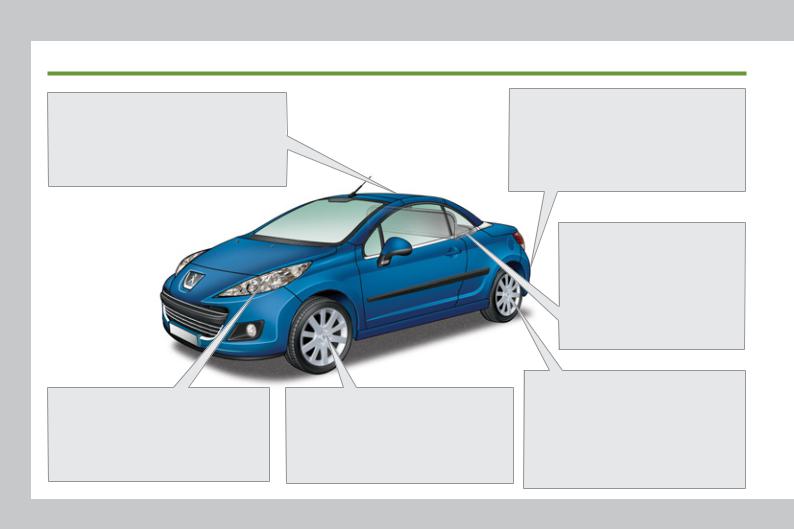
FAMILIARISATION
EXTERIOR
Retractable roof
This system enables you to change from a "coupé" configuration to a "cabriolet" configuration and vice versa with a single action.
6
Visual and audible rear parking sensors
This system provides a warning when reversing by detecting obstacles located behind the vehicle.
114
Windstop
In the "cabriolet" configuration, this system reduces wind turbulence in the front seats.
61
Directional lighting
This additional lighting automatically provides extended visibility when turning.
83
Tyre under-inflation detection
This system monitors the pressure in each tyre and warns you of a puncture or drop in pressure.
95
Temporary tyre repair kit
This kit is a complete system, consisting of a compressor and an integral sealant, for the temporary repair of a tyre.
123
4

FAMILIARISATION
OPENING
Remote control key
A. Unfolding/Folding the key. B. Unlocking the vehicle.
C. Unlocking and partially opening the boot.
65
i Also...
D. Normal locking or
Deadlocking the vehicle.
Boot
From outside
1. Unlocking the vehicle or unlocking the boot.
2. Opening the tailgate.
From inside
1. Key in the ignition switch.
2. Unlocking using the manual centralised control or the door opening control.
76
Fuel tank
1. Opening the fuel filler flap.
2. Opening and hooking the fuel filler cap.
Capacity of the tank: approximately 50 litres (petrol) or 48 litres (Diesel).
77
i On Diesel vehicles, the fuel filler neck incorporates a misfuel prevention device which prevents filling with petrol.
79
5
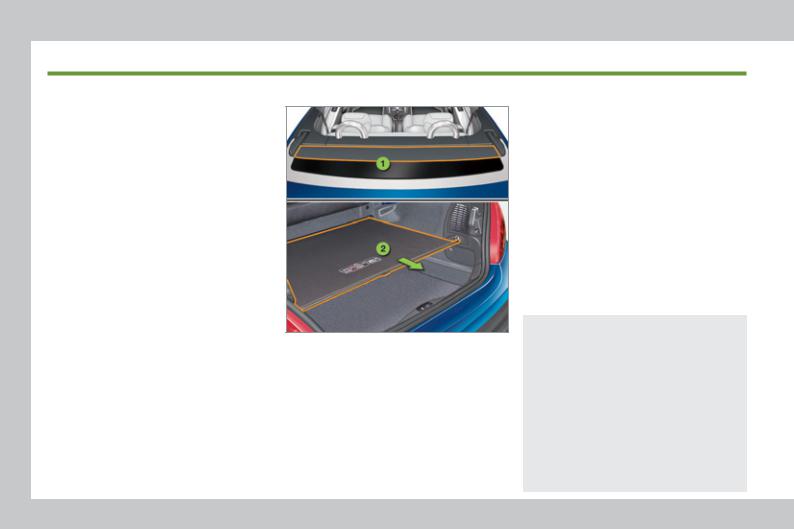
FAMILIARISATION
OPENING
Retractable roof
Precautions to be taken before operating the roof
) Park the vehicle on level ground.
)Check that no object could hinder the operation of the roof:
-nothing should be placed on the moving rear shelf 1 or on the net 2,
-if luggage is being carried in the boot, it must not raise the net,
) Ensure that the net 2 is secure. ) Close the boot correctly.
! The roof is operated under the |
|
! |
When washing your vehicle: |
|
- lock the vehicle, |
||
sole responsibility of the driver. |
|
|
- avoid spraying the upper part |
During operation of the roof, to |
|
|
of the windows, |
avoid the risk of injury, ensure |
|
|
- keep the end of the high-pres- |
that no one is in the vicinity of the |
|
|
|
|
|
sure nozzle at least 1 metre |
|
moving parts. |
|
|
|
|
|
from the windows and door |
|
You are strongly advised not to |
|
|
|
|
|
seals. |
|
operate the roof in strong winds. |
|
|
After washing the vehicle or fol- |
|
|
|
lowing rain, wait until the roof has |
|
|
|
dried before opening it. |
|
|
|
|
Preliminary conditions
) Switch on the ignition.
)Ensure that:
-the vehicle is not in energy economy mode (refer to the corresponding section),
-the battery voltage is sufficient (switching on of the indicator lamp on the roof control),
-the roof fuse is in good condition (refer to the corresponding section),
-the electric windows are initialised (refer to the corresponding section),
-the ambient temperature is above -15 °C.
iIt is preferable to operate the roof with the engine running.
The roof can be operated at speeds below 6 mph (10 km/h).
It is only possible to carry out the operation twice with the engine off, to prevent discharging of the battery.
Maintenance
Carry out a complete roof operation at least once a month to keep it in good working order.
6
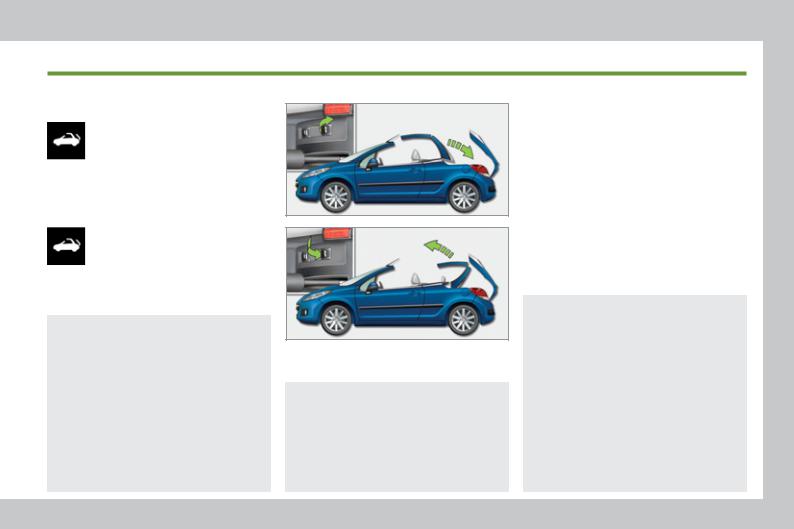
FAMILIARISATION
OPENING
Operating the retractable roof
Opening the roof
)Pull this control until the roof is fully open.
The end of the operation is confirmed by an audible signal and a message on the multifunction screen.
Closing the roof
)Press this control until the roof is fully closed.
The end of the operation is confirmed by an audible signal and a message on the multifunction screen.
!If you continue to pull or press this button after the end of the operation, the four windows close.
Do not release the roof control during a roof operation.
However, in the event of danger, release the control, the roof stops; then, when the danger is no longer present, complete the required operation.
If the operation has not been completed, you will be warned by an audible signal and a message on the multifunction screen. These will be repeated when the vehicle reaches a number of speed thresholds.
!Operating fault
If a malfunction of the roof occurs, apply the parking brake, switch off the ignition, restart the engine, then start the required operation again.
If the problem persists, contact a PEUGEOT dealer.
Changing to "cabriolet" configuration:
-the four windows lower,
-the boot opens,
-the roof folds into the boot,
-the boot closes.
Changing to "coupé" configuration:
-the four windows lower,
-the boot opens,
-The roof opens out and locks automatically,
-the boot closes.
i
The electric window controls and the control for the four windows are deactivated during roof operations.
The roof electronic control unit may stop the current operation as a precaution (example: door movement and roof operation in quick succession). In this case, release the control then activate it again to complete the required operation.
7
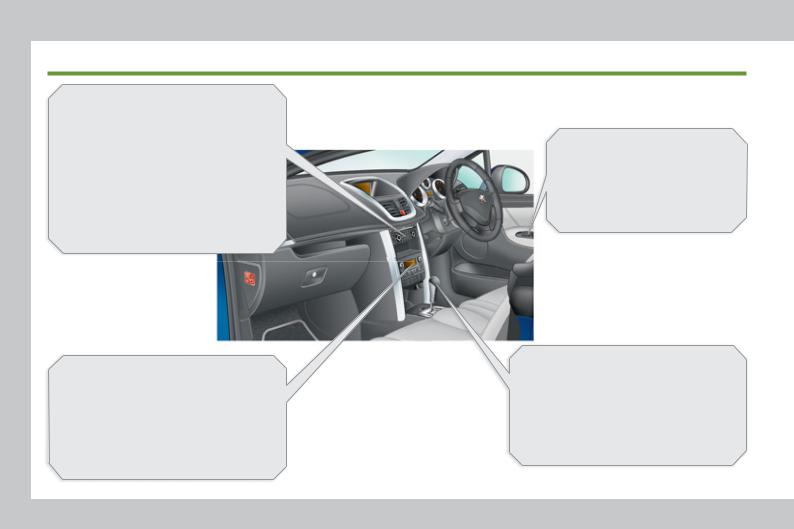
FAMILIARISATION
INTERIOR
Audio and communication systems
These systems benefits from the latest technology: MP3 compatible Peugeot Connect Sound (RD5), Peugeot Connect USB with Bluetooth hands-free system, Peugeot Connect Navigation (RNEG) with 16/9 colour screen, JBL audio system, auxiliary sockets.
Peugeot Connect Navigation (RNEG) |
157 |
Peugeot Connect Sound (RD5) |
189 |
Peugeot Connect Plug |
196 |
Dual-zone digital air conditioning
This system allows different levels of comfort for the driver and front passenger. It then controls these levels automatically, according to the ambient conditions.
50
Electric windows
On the driver’s side, control of the electric windows is automatic when opening and when closing.
71
Automatic gearbox
This system provides perfect driving by combining a fully automatic mode, associated with two special programmes, and a manual mode.
107
8
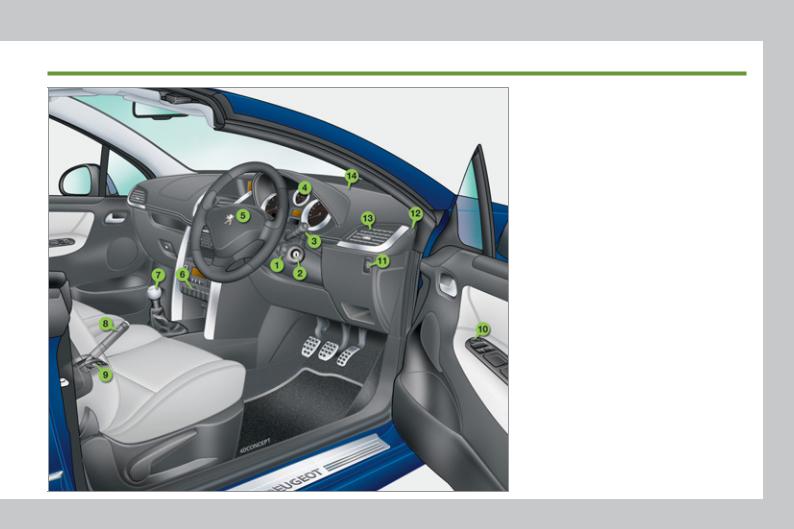
FAMILIARISATION
INSTRUMENTS AND CONTROLS
1. Audio equipment steering mounted control.
2. Steering lock and ignition.
3. Wipers/screenwash/trip computer control stalk.
4. Instrument panel.
5. Driver’s airbag.
Horn.
6. Dynamic stability control (ESP/ASR) button.
Central locking button. Alarm button.
7. Gear lever.
8. Parking brake.
9. Retractable roof control. Control for the four windows.
10. Door mirror controls. Electric window controls.
11. Headlamp height adjustment.
12. Door window demist/defrost vent.
13. Side adjustable air vent.
14. Windscreen demist/defrost vent.
9

FAMILIARISATION
INSTRUMENTS AND CONTROLS
1. Steering wheel adjustments control.
2. Cruise control/speed limiter switches.
3. Lighting and direction indicators control stalk.
4. Hazard warning lamps switch.
5. Multifunction screen.
Seat belt fastening status warning lamps.
6. Sunshine sensor.
7. Passenger’s airbag.
8. Speaker (medium tweeter).
9. Glove box/Passenger’s airbag deactivation/Audio/video sockets/ Fusebox.
10. Bonnet release lever.
11. 12 V accessory socket.
12. USB port.
13. Heating/air conditioning controls.
14. Storage compartment.
15. Audio and telematics system.
16. Central adjustable air vents.
10

FAMILIARISATION
SITTING COMFORTABLY
Front seat adjustment |
Steering wheel adjustment |
|
|
|
|
1. Forwards-backwards adjustment.
2. Height adjustment.
3. Seat back angle adjustment.
4. Head restraint height adjustment.
52
1. Unlocking the steering wheel adjustment.
2. Height and reach adjustment.
3. Locking the steering wheel adjustment.
! As a safety precaution, it is imperative that these operations are carried out when stationary.
i Also...
5. Access to the rear seats.
54
11

FAMILIARISATION
SITTING COMFORTABLY
DOOR MIRROR ADJUSTMENT |
|
Rear view mirror adjustment |
|
Front seat belts |
|
|
|
|
|
|
|
|
|
|
A. Selecting the mirror.
B. Adjusting the position of the mirror. C. De-selecting the mirror.
55
i Also...
D. Folding/Unfolding.
A. Installing the strap. B. Fastening the buckle.
C. Checking the fastening by pulling the strap.
98
1. Selecting the "day" position of the mirror.
2. Adjustment of the mirror.
56
12
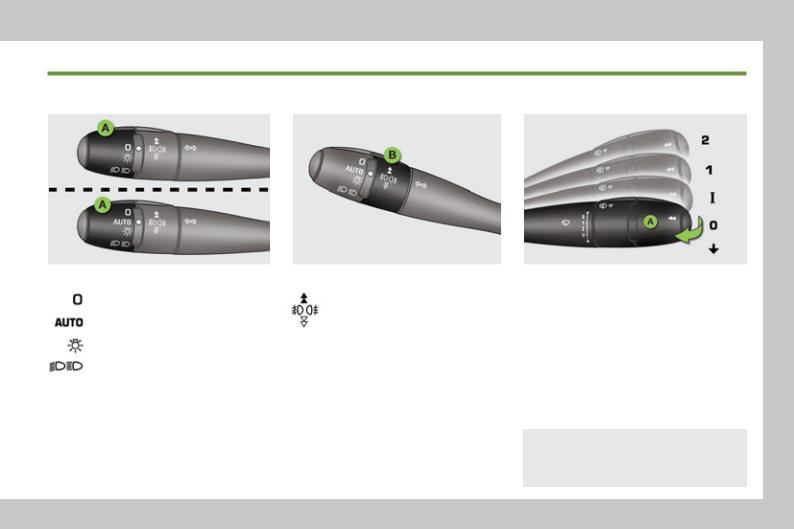
FAMILIARISATION
SEEING CLEARLY
Lighting |
Wipers |
|||
|
|
|
|
|
|
|
|
|
|
Ring A |
Ring B |
Lighting off. |
Front and rear foglamps. |
Automatic illumination of headlamps.
Sidelamps.
Dipped/main beam headlamps.
80 |
81 |
Stalk A: windscreen wipers 2. Fast wipe.
1. Normal wipe.
I. Intermittent wipe. 0. Park.
È Single wipe.
Screenwash: pull the stalk towards you.
84
i The automatic wiper function is not available on the 207CC at present.
13
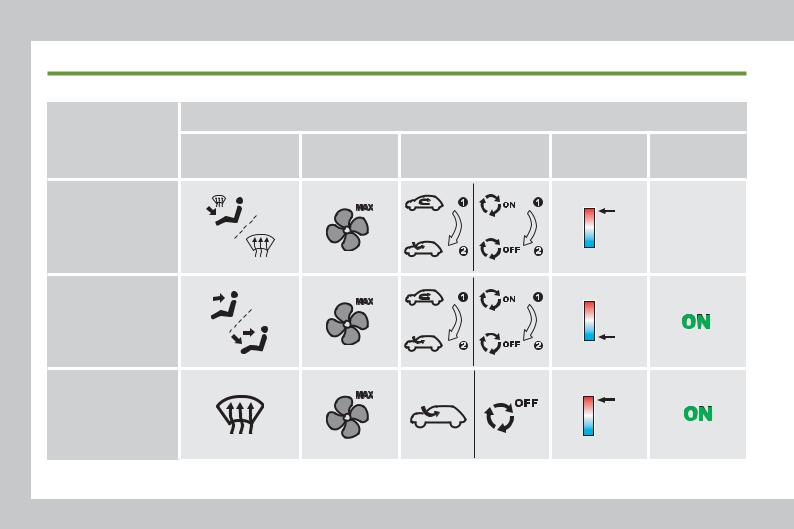
FAMILIARISATION
VENTILATION
Advice on interior settings
|
|
I require... |
|
|
Heating or Manual |
|
|
|
|
air conditioning |
Air flow |
Air recirculation/ |
Temperature |
Manual A/C |
Air distribution |
Exterior air intake |
|||
|
|
|
|
|
HEAT |
|
|
|
|
COOL |
|
|
|
|
DEMISTING |
|
|
|
|
DEFROSTING |
|
|
|
|
Digital air conditioning: use of the fully automatic mode by pressing the "AUTO" button is recommended.
14
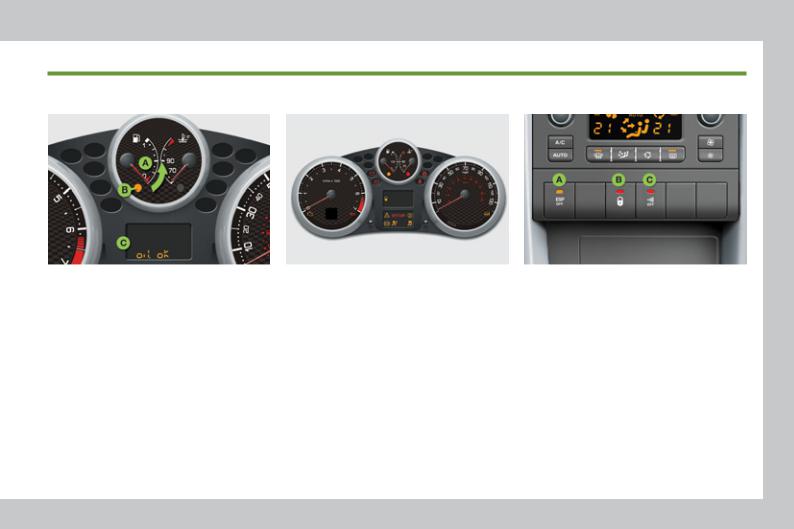
FAMILIARISATION
MONITORING
Instrument panel |
Warning lamps |
Switch panel |
||
|
|
|
|
|
|
|
|
|
|
A. With the ignition on, the fuel gauge needle should rise.
B. With the engine running, the associated low level warning lamp should switch off.
C. With the ignition on, the oil level indicator should display "OIL OK" for a few seconds.
If the levels are not correct, top up the level which is low.
20
1. With the ignition on, the orange and red warning lamps come on.
2. With the engine running, these warning lamps should switch off.
If a warning lamp remains on, refer to the page concerned.
21
Lighting of the indicator lamp indicates the status of the corresponding function.
A. Deactivation of the ESP/ASR system.
97
B. Central locking.
74
C. Deactivation of the interior volumetric protection alarm.
69
15
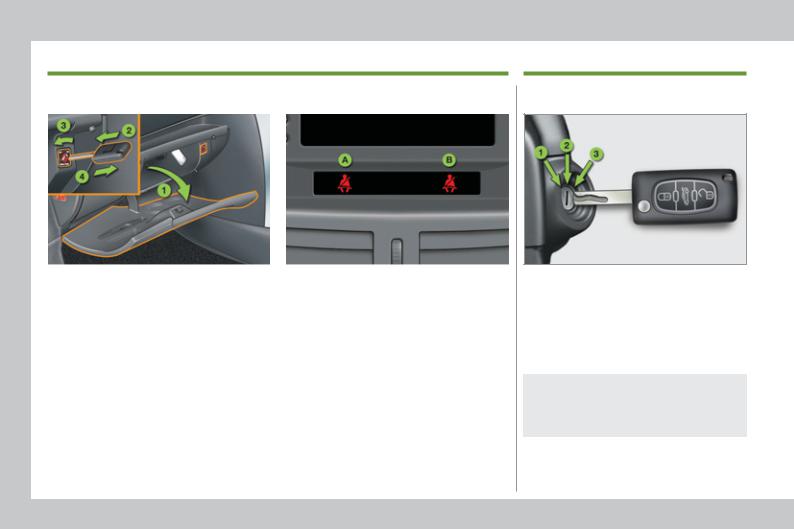
FAMILIARISATION
PASSENGER SAFETY
Front passenger’s airbag |
Front seat belts |
|
|
|
|
|
|
|
1. Open the glove box.
2. Insert the key.
3. Select position:
"ON" (activation), with front passenger or "forwards facing" child seat,
"OFF" (deactivation), with "rear facing" child seat.
4. Remove the key keeping the switch in the new position.
102
A. Front left seat belt not fastened or unfastened warning lamp lit in red.
B. Front right seat belt not fastened or unfastened warning lamp lit in red.
98
STARTING
Ignition switch
1. Stop position.
2. Ignition position.
3. Starting position.
67
!Aheavy object (key fob...), attached to the key and weighing down on its shaft in the ignition switch, could cause a malfunction.
16
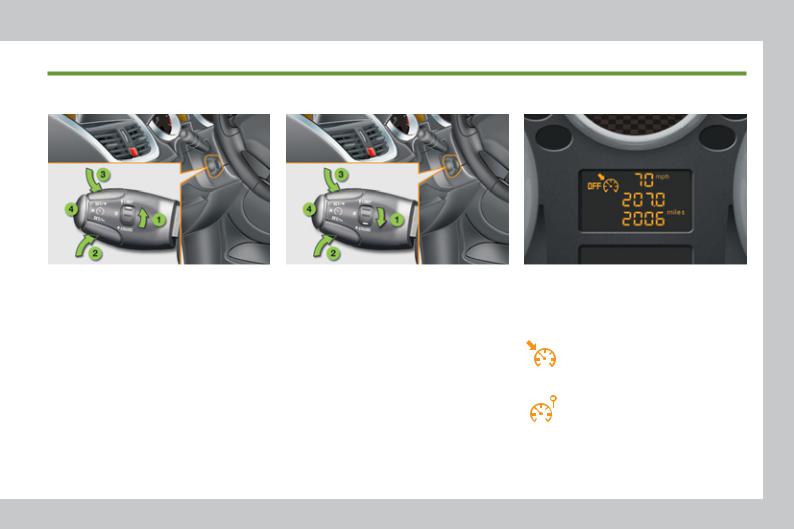
FAMILIARISATION
DRIVING SAFELY
Speed limiter "LIMIT" |
Cruise control "CRUISE" |
Display in the instrument panel |
||
|
|
|
|
|
|
|
|
|
|
1. Selecting/Switching off speed limiter mode.
2. Decrease the programmed value.
3. Increase the programmed value.
4. Speed limiter on/off.
The values must be set with the engine running.
110
1. Selecting/Switching off cruise control mode.
2. Decrease the programmed value.
3. Increase the programmed value.
4. Cruise control off/resume.
In order to be programmed or activated, the vehicle speed must be higher than 25 mph (40 km/h), with at least fourth gear engaged on the manual gearbox (second gear on the automatic gearbox).
112
The cruise control or speed limiter mode appears in the instrument panel when it is selected.
Cruise control
Speed limiter
17

ECO-DRIVING
Eco-driving is a range of everyday practices that allow the motorist to optimise their fuel consumption and CO2 emissions.
Optimise the use of your gearbox
With a manual gearbox, move off gently, change up without waiting and drive by changing up quite soon. If your vehicle has the system, the gear shift indicator invites you to change up; it is displayed in the instrument panel, follow its instructions.
With an automatic or electronic gearbox, stay in Drive "D" or Auto "A", according to the type of gearbox, without pressing the accelerator pedal heavily or suddenly.
Drive smoothly
Maintain a safe distance between vehicles, use engine braking rather than the brake pedal, and press the accelerator progressively. These practices contribute towards a reduction in fuel consumption and CO2 emissions and also helps reduce the background traffic noise.
If your vehicle has cruise control, make use of the system at speeds above 25 mph (40 km/h) when the traffic is flowing well.
Control the use of your electrical equipment
Before moving off, if the passenger compartment is too warm, ventilate it by opening the windows and air vents before using the air conditioning.
Above 30 mph (50 km/h), close the windows and leave the air vents open.
Remember to make use of equipment that can help keep the temperature in the passenger compartment down (sunroof and window blinds...).
Switch off the air conditioning, unless it has automatic digital regulation, as soon as the desired temperature is attained.
Switch off the demisting and defrosting controls, if not automatic.
Switch off the heated seat as soon as possible.
Switch off the headlamps and front foglamps when the level of light does not require their use.
Avoid running the engine before moving off, particularly in winter; your vehicle will warm up much faster while driving.
As a passenger, if you avoid connecting your multimedia devices (film, music, video game...), you will contribute towards limiting the consumption of electrical energy, and so of fuel.
Disconnect your portable devices before leaving the vehicle.
18

Limit the causes of excess consumption
Spread loads throughout the vehicle; place the heaviest items in the bottom of the boot, as close as possible to the rear seats.
Limit the loads carried in the vehicle and reduce wind resistance (roof bars, roof rack, bicycle carrier, trailer...). Use a roof box in preference.
Remove roof bars and roof racks after use.
At the end of winter, remove snow tyres and refit your summer tyres.
Observe the recommendations on maintenance
Check the tyre pressures regularly, when cold, referring to the label in the door aperture, driver’s side.
Carry out this check in particular:
-before a long journey,
-at each change of season,
-after a long period out of use.
Don’t forget the spare wheel and the tyres on any trailer or caravan.
Have your vehicle serviced regularly (engine oil, oil filter, air filter...) and observe the schedule of operations recommended by the manufacturer.
When refuelling, do not continue after the 3rd cut-off of the nozzle to avoid any overflow.
At |
the wheel |
of your |
new vehicle, |
it |
is only after |
the first |
1 800 miles |
(3 000 kilometres) that you will see the fuel consumption settle down to a consistent average.
19

INSTRUMENTS and CONTROLS
PETROL - DIESEL, MANUAL OR AUTOMATIC GEARBOX, INSTRUMENT PANELS
Panel which groups together the vehicle operation dials and indicator lamps.
Dials
1. Rev counter. |
5. Screen. |
Indicates the speed of rotation of |
6. Display zero reset button. |
the engine (x 1 000 rpm). |
Resets the selected function to |
2. Fuel gauge. |
zero (trip distance recorder or |
Indicates the quantity of fuel |
service indicator). |
remaining in the tank. |
7. Instrument panel lighting button. |
3. Coolant temperature. |
Adjusts the brightness of the |
Indicates the temperature of the |
lighting of the instruments and |
engine coolant (°Celsius). |
controls. |
4. Speedometer. |
8. Automatic gearbox. |
Indicates the current speed of the |
Indicates the programme selected |
moving vehicle (mph or km/h). |
and the gear engaged. |
Screen
A. Speed limiter or
Cruise control.
(mph or km/h)
B. Trip distance recorder.
(miles or km/h)
C. Service indicator.
(miles or km/h) then,
Engine oil level indicator. then
Distance recorder.
(km or miles)
These three functions are displayed in succession when the ignition is switched on.
For more information, refer to the section which corresponds to the function and to the display associated with it.
20

INSTRUMENTS and CONTROLS
Indicator and warning lamps
Visual indicators informing the driver that a system is in operation (operation or deactivation indicator lamps) or of the occurrence of a fault (warning lamp).
When the ignition is switched on
Certain warning lamps come on for a few seconds when the vehicle's ignition is switched on.
When the engine is started, these same warning lamps should go off.
If they remain on, before moving off, refer to the information on the warning lamp concerned.
Associated warnings
The illumination of certain warning lamps may be accompanied by an audible signal and a message in the multifunction screen.
Operation indicator lamps
If one of the following indicator lamps comes on, this confirms that the corresponding system has come into operation.
!The warning lamps may come on continuously (fixed) or flash.
Certain warning lamps may come on in two different modes. Only by relating the type of illumination to the operating status of the vehicle can it be ascertained whether the situation is normal or whether a fault has occurred.
Warning lamp |
is on |
Cause |
Action/Observations |
|
Left-hand |
flashing with |
The lighting stalk is pushed |
|
|
direction |
|
|||
buzzer. |
down. |
|
||
indicator |
|
|||
|
|
|
||
Right-hand |
flashing with |
The lighting stalk is pushed |
|
|
direction |
|
|||
buzzer. |
up. |
|
||
indicator |
|
|||
|
|
|
||
Dipped beam |
|
The lighting stalk is in the |
|
|
fixed. |
"Dipped beam headlamps" |
|
||
headlamps |
|
|||
|
position. |
|
||
|
|
|
||
Main beam |
fixed. |
The lighting stalk is pulled |
Pull the stalk to return to dipped beam |
|
headlamps |
towards you. |
headlamps. |
||
|
21
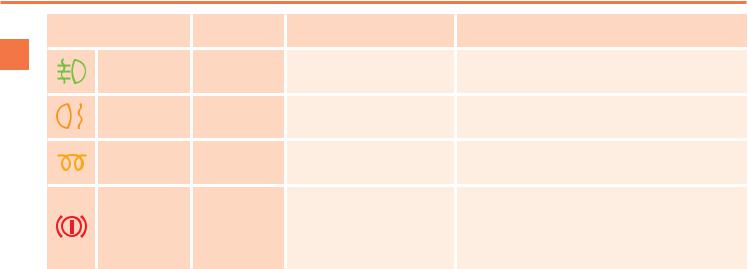
INSTRUMENTS and CONTROLS
Warning lamp |
is on |
Cause |
Action/Observations |
|
|
Front |
fixed. |
The front foglamps are |
Turn the ring on the stalk rearwards twice to |
|
foglamps |
switched on. |
switch off the front foglamps. |
|
|
|
|||
|
Rear |
fixed. |
The rear foglamps are |
Turn the ring on the stalk rearwards to switch off |
|
||||
|
foglamps |
switched on. |
the rear foglamps. |
|
|
|
|||
|
Diesel engine |
fixed. |
The ignition switch is at the |
Wait until the warning lamp has switched off before starting. |
|
pre-heating |
2nd position (ignition on). |
The duration for which the warning lamp is on is |
|
|
|
|
|
determined by the climatic conditions. |
|
|
|
|
Release the parking brake to switch off the |
|
|
|
The parking brake is |
warning lamp, keeping your foot on the brake |
|
Parking brake |
fixed. |
pedal. |
|
|
applied or not properly |
Observe the safety recommendations. |
||
|
|
|
released. |
|
|
|
|
For further information on the parking brake, refer |
|
|
|
|
|
|
|
|
|
|
to the "Driving" section. |
22
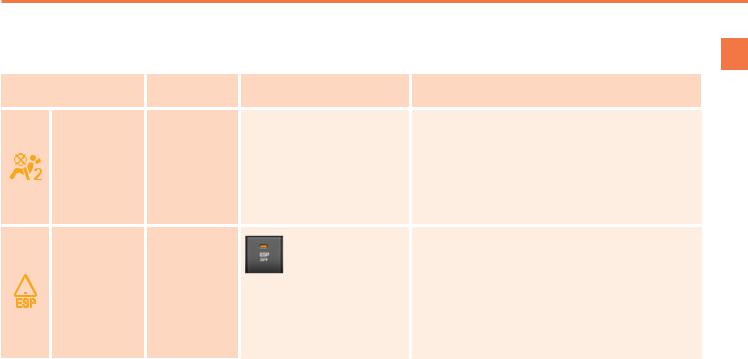
INSTRUMENTS and CONTROLS
Deactivation indicator lamps
If one of the following indicator lamps comes on, this confirms that the corresponding system has been switched off intentionally. This is may be accompanied by an audible signal and a message on the multifunction screen.
|
Warning lamp |
is on |
Cause |
Action/Observations |
|
|
|
The control, located in the |
|
|
|
|
glove box, is set to the OFF |
Set the control to the ON position to activate the |
|
Passenger's |
|
position. |
|
|
fixed. |
passenger's front airbag. |
||
|
airbag |
The passenger's front |
In this case, do not fit a child seat in the rear-facing |
|
|
system |
|
airbag is deactivated. |
|
|
|
|
In this case you can install |
position. |
|
|
|
a "rear facing" child seat. |
|
|
|
|
The button, located |
|
|
|
|
in the centre of |
Press the button again to reactivate |
|
|
|
the dashboard, |
|
|
|
|
the ESP/ASR manually. Its indicator lamp |
|
|
|
|
is pressed. Its |
|
|
|
|
goes off. |
|
|
ESP/ASR |
fixed. |
indicator lamp is on. |
|
|
The ESP/ASR is |
From approximately 30 mph (50 km/h), |
||
|
||||
|
|
|
deactivated. |
the system is reactivated automatically. |
|
|
|
The ESP/ASR system is reactivated |
|
|
|
|
ESP: electronic stability |
|
|
|
|
automatically when the vehicle is started. |
|
|
|
|
programme. |
|
|
|
|
|
|
|
|
|
ASR: anti-slip regulation. |
|
23
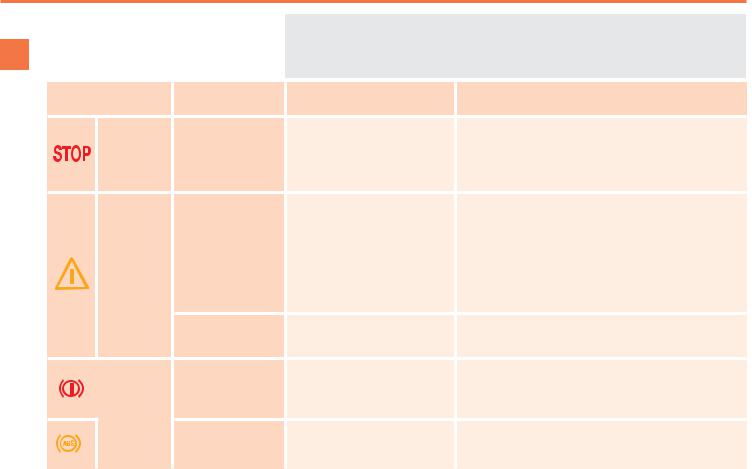
INSTRUMENTS and CONTROLS
Warning lamps
When the engine is running or the vehicle is being driven, the illumination of one of the following warning lamps indicates a fault which requires action on the part of the driver.
!Any fault resulting in the illumination of a warning lamp must be investigated further by reading the associated message in the multifunction screen.
If you encounter any problems, do not hesitate to contact a PEUGEOT dealer or a qualified workshop.
Warning lamp |
is on |
Cause |
Action/Observations |
|
|
fixed, alone or |
Illumination of the warning |
Stop as soon as it is safe to do so as the engine |
|
|
associated with |
|||
|
lamp is associated with a |
|||
STOP |
another warning lamp, |
may cut out when driving. |
||
serious braking system or |
||||
accompanied by an |
Park, switch off the ignition and call a PEUGEOT |
|||
|
engine coolant temperature |
|||
|
audible signal and a |
dealer or a qualified workshop. |
||
|
problem. |
|||
|
message on the screen. |
|
||
|
|
|
Identify the problem by reading the message |
|
|
|
|
shown in the screen, such as, for example: |
|
|
|
|
- the engine oil level, |
|
|
|
Minor problems have |
- the screenwash level, |
|
|
temporarily. |
occurred for which there is |
- the remote control battery, |
|
Service |
|
no specific warning lamp. |
- saturation of the particle emission filter on Diesel |
|
|
|
vehicles (see "Checks - § particle emissions filter"). |
||
|
|
|
For any other faults, contact a PEUGEOT dealer |
|
|
|
|
or a qualified workshop. |
|
|
fixed. |
Major problems have |
Identify the problem by reading the message |
|
|
occurred for which there is |
shown in the screen and contact a PEUGEOT |
||
|
|
no specific warning lamp. |
dealer or a qualified workshop. |
|
|
fixed, associated |
|
You must stop as soon as it is safe to do so. Top |
|
|
The braking system fluid |
up with brake fluid recommended by PEUGEOT. |
||
|
with the STOP |
|||
|
level is too low. |
If the problem persists, have the system checked |
||
|
warning lamp. |
|||
Braking |
|
by a PEUGEOT dealer or a qualified workshop. |
||
|
|
|||
|
|
|
||
|
fixed, associated |
The electronic brake force |
You must stop as soon as it is safe to do so. |
|
+ |
with the STOP and |
distribution (EBFD) system |
Have it checked by a PEUGEOT or a qualified |
|
|
ABS warning lamp. |
has a fault. |
workshop. |
24

|
|
|
|
|
|
|
INSTRUMENTS and CONTROLS |
|
|
|
|
|
|
|
|
|
|
|
|
Warning lamp |
is on |
Cause |
Action/Observations |
|
|
|
|
Anti-lock |
|
|
The vehicle retains conventional braking. |
|
|
|
|
Braking |
fixed. |
The anti-lock braking |
Drive carefully at reduced speed and contact |
|
|
|
|
System |
system has a fault. |
a PEUGEOT dealer or a qualified workshop |
|
|
|
|
|
|
|||
|
|
|
|
(ABS) |
|
|
without delay. |
|
|
|
|
|
flashing. |
The ESP/ASR regulation is |
The system optimises traction and improves the |
|
|
|
|
Dynamic |
active. |
directional stability of the vehicle. |
|
|
|
|
|
|
|||
|
|
|
|
|
|
|
|
|
|
|
|
stability |
|
|
|
|
|
|
|
|
|
|
|
|
|
|
|
control |
|
Unless it has been |
|
|
|
|
|
(ESP/ASR) |
fixed. |
deactivated (button pressed |
Have it checked by a PEUGEOT or a qualified |
|
|
|
|
|
and its indicator lamp on) the |
workshop. |
|
|
|
|
|
|
|
||
|
|
|
|
|
|
ESP/ASR system has a fault. |
|
|
|
|
|
|
flashing. |
The engine management |
Risk of destruction of the catalytic converter. |
|
|
|
|
|
Have it checked by a PEUGEOT dealer or a |
||
|
|
|
|
|
system has a fault. |
||
|
|
|
|
Engine |
|
qualified workshop. |
|
|
|
|
|
|
|
||
|
|
|
|
|
|
|
|
|
|
|
|
autodiagnosis |
|
|
The warning lamp should go off when the engine |
|
|
|
|
system |
|
|
|
|
|
|
|
fixed. |
The emission control |
is started. |
|
|
|
|
|
|
system has a fault. |
If it does not go off, contact a PEUGEOT dealer |
|
|
|
|
|
|
|
||
|
|
|
|
|
|
|
or qualified workshop without delay. |
|
|
|
|
|
|
|
You must refuel as soon as possible to avoid |
|
|
|
|
|
|
|
running out of fuel. |
|
|
|
|
|
|
|
This warning lamp will come on every time the |
|
|
|
|
|
|
When it first comes on there |
ignition is switched on, until a sufficient addition |
|
|
|
|
Low fuel |
fixed. |
of fuel is made. |
|
|
|
|
|
level |
remains approximately |
Fuel tank capacity: approximately 50 litres |
|
|
|
|
|
|
5 litres of fuel in the tank. |
||
|
|
|
|
|
|
(petrol) or 48 litres (Diesel). |
|
|
|
|
|
|
|
|
|
|
|
|
|
|
|
|
Never continue to drive until you run out of fuel |
|
|
|
|
|
|
|
as this could damage the emission control and |
|
|
|
|
|
|
|
injection systems. |
25

INSTRUMENTS and CONTROLS
Warning lamp |
is on |
Cause |
Action/Observations |
|
Maximum |
|
|
Stop as soon as it is safe to do so. |
|
|
The temperature of the |
Wait until the engine has cooled down before |
||
coolant |
fixed red. |
topping up the level, if necessary. |
||
cooling system is too high. |
||||
temperature |
|
If the problem persists, contact a PEUGEOT |
||
|
|
|||
|
|
|
dealer or qualified workshop. |
|
Engine oil |
fixed. |
There is a fault with the |
You must stop as soon it is safe to do so. |
|
Park, switch off the ignition and contact a |
||||
pressure |
engine lubrication system. |
|||
|
|
|
PEUGEOT dealer or a qualified workshop. |
|
Battery |
|
The battery charging circuit |
The warning lamp should go off when the engine |
|
fixed. |
has a fault (dirty or loose |
is started. |
||
charge* |
terminals, slack or cut |
If it does not go off, contact a PEUGEOT dealer |
||
|
||||
|
|
alternator belt, ...). |
or a qualified workshop. |
|
|
fixed if the |
|
|
|
|
speed is |
|
|
|
|
below 6 mph |
|
|
|
|
(10 km/h). |
|
|
|
Door(s) |
fixed and |
A door, the boot or the rear |
Close the door or boot. |
|
open |
accompanied |
screen is still open. |
||
|
||||
|
by an audible |
|
|
|
|
signal if the |
|
|
|
|
speed is |
|
|
|
|
above 6 mph |
|
|
|
|
(10 km/h). |
|
|
26 |
* According to destination country. |
|
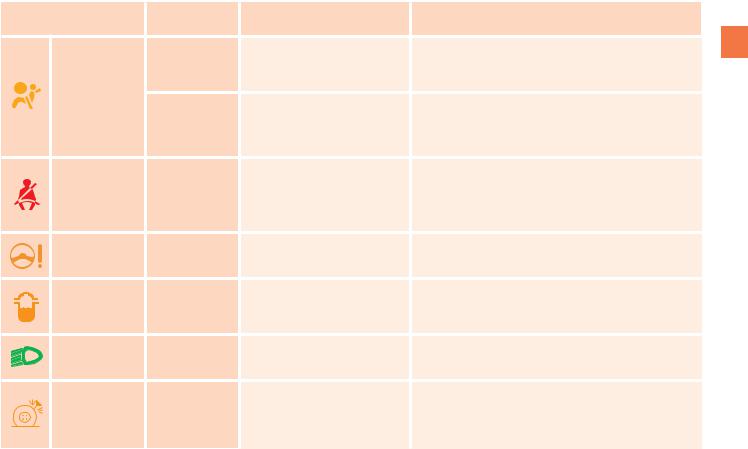
|
|
|
INSTRUMENTS and CONTROLS |
|||
|
|
|
|
|
|
|
Warning lamp |
is on |
Cause |
Action/Observations |
|||
|
|
This lamp comes on for a |
This lamp should go off when the engine is |
|||
|
temporarily. |
few seconds when you turn |
started. |
|||
|
on the ignition, then goes |
If it does not go off, contact a PEUGEOT dealer |
||||
|
|
|||||
|
|
off. |
or a qualified workshop. |
|||
Airbags |
|
|
|
|
|
|
|
|
One of the airbag or seat |
Have it checked by a PEUGEOT dealer or a |
|||
|
fixed. |
belt pretensioner systems |
||||
|
qualified workshop. |
|||||
|
|
has a fault. |
||||
|
|
|
|
|
||
|
fixed then |
The driver and/or the front |
|
|
|
|
Seat belt not |
flashing |
|
|
|
||
accompanied |
passenger has not fastened |
Pull the strap then insert the tongue in the |
||||
fastened/ |
||||||
by an |
or has unfastened their seat |
buckle. |
||||
unfastened |
||||||
increasing |
belt. |
|
|
|
||
|
audible signal. |
|
|
|
|
|
Power |
fixed. |
The power steering has a |
Drive carefully at reduced speed. |
|||
Have it checked by a PEUGEOT dealer or a |
||||||
steering |
fault. |
|||||
|
|
|
qualified workshop. |
|||
|
|
|
Risk of damage to the injection system on Diesel |
|||
Water in |
fixed. |
The Diesel fuel filter |
engines. |
|||
Diesel |
contains water. |
Contact a PEUGEOT dealer or a qualified |
||||
|
||||||
|
|
|
workshop without delay. |
|||
Directional |
flashing. |
The directional headlamps |
Have it checked by a PEUGEOT dealer or a |
|||
headlamps |
system has a fault. |
qualified workshop. |
||||
|
||||||
|
|
|
Stop immediately avoiding any sharp action on |
|||
Punctured |
|
One or more wheels are |
the steering wheel or the brakes. |
|||
fixed. |
punctured or seriously |
Repair or change the damaged wheel and have |
||||
wheel |
||||||
|
|
deflated. |
the pressure of the tyres checked as soon as |
|||
|
|
|
possible. |
|||
|
|
|
|
|
|
|
|
|
|
|
|
|
|
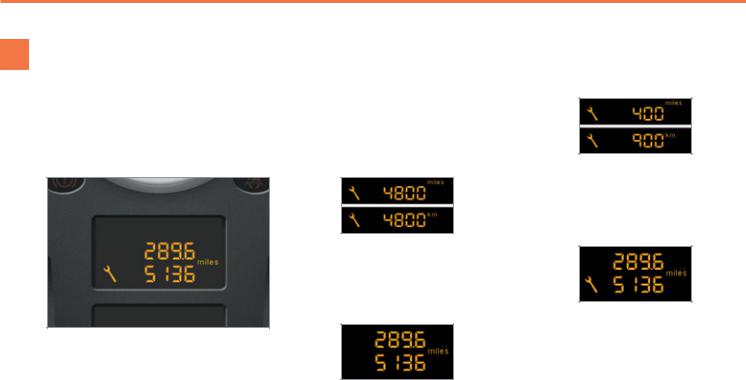
INSTRUMENTS and CONTROLS
Service indicator
System which informs the driver when the next service is due, in accordance with the manufacturer's servicing schedule.
The point at which the service is due is calculated from the last indicator zero reset. It is determined by two parameters:
-the distance travelled,
-the time elapsed since the last service.
More than 1 000 km remain before the next service is due
For 5 seconds after the ignition is switched on, the spanner symbolising the service operations comes on. The distance recorder display line indicates the distance remaining before the next service is due.
Example: 4 800 km remain before the next service is due.
For 5 seconds after the ignition is switched on, the display indicates:
5 seconds after the ignition is switched on, the spanner goes off; the distance recorder resumes its normal operation. The display then indicates the total and trip distances.
Less than 1 000 km remain before the next service is due
Example: 900 km remain before the next service is due.
For 5 seconds after the ignition is switched on, the display indicates:
5 seconds after the ignition is switched on, the distance recorder resumes its normal operation. The spanner remains on to indicate that a service must be carried out soon.
28
